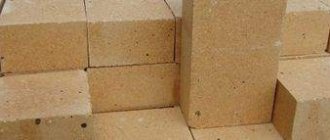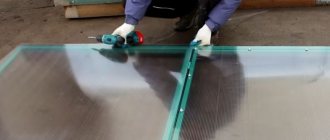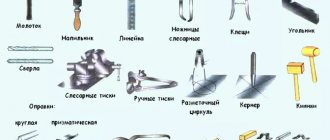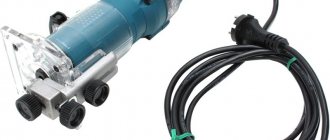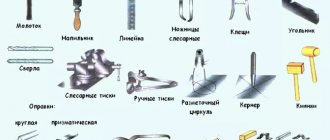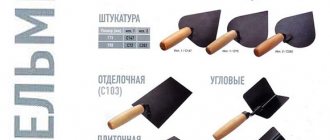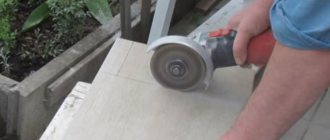Features of cutting bricks
Brick is a durable wall material that can withstand multi-ton static loads. But it is also characterized by fragility and fragility. Therefore, a hammer drill or jackhammer is not suitable for cutting ceramic products. The thinner and sharper the cutting surface, the sharper the cut will be, and the less chance of chipping.
The key to a quality cut is reliable fixation of the brick. To do this, you can use both special devices and improvised means. Before work, you need to thoroughly moisten the product. This will help avoid a lot of dust during the cutting process.
A well-moistened brick is the key to a quality cut Source ytimg.com
The wide variety of tools for cutting wall products can be divided into two groups: manual and electric. They can be used both at construction sites and at home.
How to cut brick with a grinder without dust?
Maxim Yesorov
Guys, do not place the grinder with the disc facing up as in the video, because based on the design of the gearbox, all the lubricant heated by the friction of the gears swells from the gears (in the place where the engine shaft transmits torque to the shaft on which the disc itself is attached. PLAY THE GRINDER AND STORE WITH THE DISC DOWN, this will extend its service life.
Don Migell
Zharyk
When I cut a part. I definitely fix it with a pipe or lever. I press my foot. so that the part does not roll or the disk
cobbvd
Master, you must wear safety glasses when working.
Manufacturing of blanks
Cutting bricks with a grinder is necessary in small-scale production. For individuals or teams of builders, it is unprofitable to buy specialized equipment and have to use more universal ones.
To cut bricks with a grinder, you need a power tool for a circle with a diameter of 230 mm.
To cut bricks with a grinder, it is better to use diamond blades.
When using a grinder with a 180th circle, it will not be possible to cut the brick to its full thickness; you will have to turn it over, which significantly reduces the productivity and convenience of work, and you will not get an even cut in two passes.
A grinder for cutting bricks should be powerful enough. For long tool life and comfortable speed of work, you need an angle grinder
power of about 2 kW or more. Too powerful machines are not desirable, because they, as a rule, have a fairly large mass and dimensions, which contributes to rapid fatigue when working with an angle grinder and reduces the overall operating comfort. It is convenient to refine surfaces with a 125 mm grinder.
When using an angle grinder, do not forget about safety precautions. Be sure to wear safety glasses.
There are two main types of stone wheels: abrasive and diamond. Perhaps the only advantage of a standard abrasive wheel is its relative cheapness. The cheapness is relative, since conventional abrasive wheels are subject to rapid wear and must be replaced frequently. They are also inconvenient to work with, since when grinding such a circle, its diameter constantly decreases, and it cuts to its full depth only at the very beginning of use. Abrasive wheels from different manufacturers can vary greatly in quality and service life. As a rule, a good abrasive wheel for stone has double reinforcement and a thickness of 2.5-3 mm. Working with an abrasive wheel is dangerous, because it is more susceptible to deformation and destruction.
READ How to Disassemble a Small Grinder
A diamond wheel is preferable; it maintains a constant diameter during operation. One good quality diamond wheel can outlast dozens of regular abrasive wheels. The diamond blade has a strong steel base, as a result of which the likelihood of its destruction is negligible.
Splitting and chiseling of bricks: a – correct splitting across; b – incorrect splitting across; c – splitting along; d – working position when hewing; d – working position when splitting.
There are several types of such circles. The simplest circles with a solid edge are cheaper than others, but have significant disadvantages. During operation, they become very hot, which can cause emergency wear of the disk. To avoid this, it is necessary to take breaks during work. The service life of such disks is the lowest. The advantage of a solid disk edge is the high quality of the cut surface without scoring or chipping.
The most common diamond wheels are segmented ones. Their cutting edge is divided into separate sections by radial cuts. This design allows for efficient removal of sludge and ventilation of the cutting area. This is a good choice for cutting brick with a grinder. They are usually used for dry cutting. When water is supplied, the segmental grooves become clogged with wet cutting products, which deteriorates the properties of the disc.
The best option would still be a disc with a turbocharged edge. It has a serrated surface, which gives the disc greater strength and rigidity. The arrangement of the teeth on the edge of the disc in a spiral creates the effect of a centrifugal pump, which perfectly allows for the removal of wet or dry sludge. Discs of this design are the most durable and cut brick and masonry stones of any type.
Before cutting brick
grinder, you must first make the markings. This is done with a construction pencil and a square. It is necessary to take into account the thickness of the disc and the play on the spindle of the angle grinder. If you draw a line just to the right size, you will most likely fail. The cut brick will be 1.5-2 mm shorter than the required size.
For cutting brick, it is best to use diamond blades with a turbocharged edge. They are well suited for working with particularly durable materials.
Cutting brick with a grinder is quite difficult, and it requires a certain skill, because the disc
must be positioned strictly vertically and not deviate until the process is completed.
In an inexperienced hand, the instrument “walks” on its weight. If this is your first time cutting brick with a grinder, it is better to try your hand and practice first. Inexpensive rough masonry bricks will do, or find some used ones. You can also make a preliminary cut a few mm deep. It helps a little to center the circle during basic cutting and is better visible in conditions where the pencil line quickly becomes covered with sludge. under the brick you are cutting. This way you will save the disk
and it will be easier to hold the instrument.
If it so happens that at the moment there is no large grinder, but cutting brick
If necessary, you can make a cut around the perimeter with a small grinder. Then all that remains is to carefully beat off the excess and clean the cut with the same machine.
Sometimes, in order to prevent the workpiece from moving during the cutting process, the brick is clamped into special devices, where the brick is secured against vertical and lateral movement.
Alexandra Mother
Muddy too much unnecessary chatter
Hand tool
Most often, hand tools are used for minor masonry work or repairs. The main equipment is a construction chisel or pick, a regular hammer (not a mallet). Hand protection is required.
Cutting bricks on sand Source blogspot.com
To cut a product, you need to scratch an even cutting line on all edges. Its depth should be up to 5 mm. After that, the chisel or pick needs to be placed in the groove and hit the tool well. Rigid fixation is not needed. The brick can be placed on a soft surface or picked up so that the part to be separated does not have support.
This method has disadvantages:
- It will be possible to cut normally only at a right angle.
- The side of the chip is uneven. It will need to be masked or more masonry mortar used.
Algorithm for cutting bricks Source infourok.ru
A hacksaw for metal will help you cut bricks at home more accurately. It should have a tungsten coating on the working surface. Regular hand saws and hacksaws will not work. They will only become dull or even “lose teeth” when the brick is separated into parts.
When working with a hacksaw, rigid fixation is desirable, but not required. Before work, it is recommended to core the brick and lay it so that the part to be sawn is unsupported. This will make it easier to make the cut.
See also: Catalog of companies that specialize in the construction of brick houses and related work
Cutting an opening in a brick wall
Diamond cutting is considered the leading technology for creating openings in brick structures. The choice of equipment is determined by the complexity and scale of the work performed. The following devices equipped with diamond tools are used:
- angle grinder;
- petrol cutter;
- seam cutter;
- diamond wire;
- laser equipment;
- wall cutting machine.
Modern tools that help craftsmen cut fireclay or sand-lime bricks are attractive due to their high processing accuracy and ease of use . They significantly reduce the time spent on the operation; the edges of the resulting materials are distinguished by a smooth surface.
You can cut building materials using the following devices :
For small volumes of work, a grinder is suitable, and for large-scale production, stone-cutting machines are usually used. Petrol cutters and laser machines are used when sawing brick walls , but the second option is expensive equipment, so choosing it at home will be unprofitable.
Durable fireclay brick is quite difficult to saw, and the process itself is accompanied by a large emission of sparks. Pre-soaking it in water for 15 minutes helps solve the problem.
Cutting an opening in a brick wall
A budget option for creating a door or window opening in a wall is to gouge it out with a sledgehammer. In this case, the operation is considered dangerous, since there is a risk of the wall breaking due to weakening of the stone ligament.
The nuances of getting an opening using a sledgehammer:
- the sizes are taken a little larger than usual, their width is increased by 0.6 cm, and their height by 1 cm;
- the surface in the right place is cleaned of plaster;
- first, use a screwdriver to pick out the binding solution, and then hit the bricks with a sledgehammer, starting from the top strip;
- Having removed the first row, insert the upper support beam and fill it with concrete mortar;
- after the composition “sets”, perform identical actions to remove the next strip.
When making a window opening, you need to take into account that its lower edge should run along the edge of the cement belt.
After using a sledgehammer, the wall must be trimmed with a grinder , since the bricks are placed “in a dressing.” On such halves, cuts are made with a tool, and then the building materials are carefully beaten with a hammer.
The leading technology that ensures maximum quality of work is diamond cutting . The price of such an operation is higher, but it is safer, since the dustiness during its implementation is minimal. The advantages also include a low noise threshold of operation and obtaining smoother cut edges. During diamond cutting, bricks do not fall out of the working area.
When creating an opening, use a grinder at the final stage
Electric tool
Depending on the type of cutting, you can choose the right power tool for the task.
Jigsaw or miter saw - for those who don’t need much
For small masonry work, you can use an electric jigsaw. It will cope well with simple cuts. But it does not have enough power to process large quantities of stone. You just need to choose the right working surface.
Grinder - “a lifesaver from the garage”
The most common of them is the grinder. If you take it only for processing ceramic products, then it is better to choose a model with a higher power, since a large load is expected with low power. The best option would be a tool with a power of at least 2 kW. You can choose something more powerful. But, as a rule, such instruments are heavy and massive. It will simply be difficult to work with them all the time.
The right grinder is the key to success Source yandex.net
It is worth considering that when using an angle grinder, the material will become very dusty, even if it is thoroughly moistened with water before starting work. Therefore, it is best to carry out all work outdoors or in a well-ventilated area. It would be useful to use personal protective equipment.
Cutting with a grinder is a dusty business Source bladesandbits.com
For such work, depending on the purpose, different disks are used:
- Abrasive . Cheaper and wears out quickly. By reducing the diameter, it is impossible to make deep cuts. Good for small volumes and simple cuts of bricks in wall masonry.
- Diamond . They have a longer service life. Cuts more accurately and safely. With them you don’t have to worry about how to cut a brick wall. Effectively make any holes in ceramics of any brand. Ideal for fitting products to face or Bulgarian masonry.
Note! You need to use discs with a diameter of 230 cm. If you take less, this will affect the quality of the cut. The width of the circle is also not enough for a complete cut. This means you have to turn the brick over. This may lead to inaccurate division. To process the cut you will need a circle with a diameter of 125 cm.
Frost resistance classes
Frost resistance is the ability of a material to withstand successive freezing and thawing without any consequences, without significant loss of appearance - the appearance of peeling, chipping, loss of technical characteristics. According to GOST, the following classes are distinguished:
- F15;
- F25;
- F35;
- F50.
The classification indicates the durability of sand-lime brick. Any grade of stone is allowed for construction. Facing according to GOST has an indicator of at least 35.
Density and weight
The silicate block is manufactured in 2 classes:
The density changes according to the class. Hollow stone is characterized by an average density, limited to 1100 to 1500 kg per m3. Solid brick has a density exceeding 1500 kg per m3. This classification is characterized by the degree of filling of the stone volume with a solid substance.
Density is determined by the ratio of the volumetric weight of the dry substance to its specific gravity, expressed as a percentage. The remaining portion of the volume is accounted for by voids and pores. The weight of a stone is directly dependent on its density, size and shape. The weight of the material is affected not only by the percentage of density, but also by the level of porosity. The weight standard according to GOST 530-2012 for white sand-lime brick is as follows:
- ordinary single - 3.2 kg;
- one and a half - 3.7 kg;
- double - 5.4 kg;
- facial one-and-a-half - from 3.7 to 4.3 kg;
- double - up to 5.8 kg.
Radiation activity
The criterion is regulated by the GOST 30108-94 standard. According to its requirements, the activity of natural radionuclides should not exceed 370 Bq/kg. The danger of radioactive building materials is that the radiation emanating from them can worsen the ecology of the premises. As a result, people are concerned about:
- headache;
- allergy;
- weakness.
But the level of background radiation when using this kind of raw material does not exceed safe limits. In terms of radiation, the block is characterized by minimal indicators in comparison with both natural and artificial building materials.
READ How to Cut OSB Plate
Video description
How the Stihl GS 461 chain cutter works is shown in this video:
Specialized equipment not only for professional builders
Professional machines greatly simplify the work of cutting bricks. With their help, you can obtain artificial ceramic stone of even complex geometric shapes. Moreover, working on such machines is much safer than when using an angle grinder and a gas cutter. The productivity of masonry work increases by 20%. The level of quality and aesthetics of masonry will also increase.
The basis is a frame with a gripping and fixing system. Cutting is done using diamond discs. Depending on the machine model, large blades (up to 420 mm) and smaller ones with a diameter (230 mm) are installed. It is worth considering that large circles are expensive, and in many cases you can get by with a regular 230 mm circle.
Large machine for cutting stone Source generaltool.ru
Precautions when working with an angle grinder
Before you begin all work, you should familiarize yourself with the basic requirements and rules for working with cutting tools. The first thing to remember. Hold the tool with both hands. Despite its simplicity, this requirement is the most important, since the strong grip of the grinder guarantees high precision work. The rebound will not significantly displace the tool and, of course, will not be able to tear it out of your hands. It is also very important to choose a comfortable position in which you do not risk losing your balance.
The power cable must be laid so that it is at the maximum distance from the working area of the tool to prevent the possibility of their contact with each other. Otherwise, the cable may be cut or wrapped around the drive. These situations are very unpleasant, since there is a risk of a short circuit or a river stopping the circle with subsequent movement of the device. It is also prohibited to place a grinding machine with a stationary rotating wheel on any surface.
READ What gasoline to fill a Husqvarna chainsaw with?
Cutting bricks using an angle grinder. A fairly simple procedure, but complete concentration is required to perform it safely. Be aware of dust generation during processing. To remove dust, a protective shell is used, which is equipped with a vacuum cleaner attachment. If waste collection cannot be arranged, a breathing mask should be worn. You can also pour water into the work area and ventilate the area frequently.
The main problem that may arise during operation. This is a backlash. This is an unexpected tool through a jammed wheel. The disk almost always fails. This situation may arise due to the fact that the direction of movement of the grinding machine is opposite to the direction of the cutting tool. In most cases, recoil is a consequence of the employee’s wrong actions. To protect yourself from such troubles, you should remember the following rules:
- Stand in a place where the instrument does not bounce when reflected, otherwise there is a risk of injury.
- You also need to hold the instrument firmly with both hands.
Sand-lime brick
Sand-lime brick is made from refined sand and lime additives. The composition is usually mixed at a percentage of ninety to 10%, but some manufacturers change the proportions slightly, depending on the quality of the components used.
Sand-lime brick samples
In order for the product to be of high quality, conscientious manufacturers first clean the sand from clay inclusions, potassium permanganate and organic impurities, and choose lime with a low content of calcium oxide.
: checking the quality of bricks by ear
- Chips When choosing a brick, you need to purchase one piece in the batch and divide it in half. It is easier to determine quality by the internal structure than by examining solid bricks. The uniformity of the material on the chip indicates its quality. The structure should not contain foreign matter, including pieces of clay. Their presence indicates a violation of production technology.
Types of bricks by functionality
In addition to the above-mentioned classification of bricks according to the material of manufacture, it is also divided according to areas of application.
Hollow brick
Empty bricks have a different percentage of empty bricks from the total mass of the product. Thus, sand-lime brick has cavities that make up 2430% of the total volume. Ceramic building material can contain up to 45% voids of one configuration or another.
Bricks with internal voids are usually not used for the furnace.
Cavities inside a brick do not make it faulty at all, but only increase its sound and heat insulation. The cells trap heat and create a cushion of air that prevents sound from penetrating. Very useful properties for the walls of houses, but these qualities are absolutely not in demand for laying stoves and fireplaces.
Hollow brick is not suitable for heating structures because it is afraid of thermal shock when the temperature drops with a large amplitude. They contribute to the creation of tension around internal voids, which leads to the inevitable destruction of their walls. In addition, as already mentioned, the low thermal conductivity of the material for the furnace is not at all a good thing.
Main types of bricks
Today, there is a wide range of different types of bricks on sale, which differ in several key parameters.
- According to manufacturing materials:
- For use in construction:
- Interior design:
Types of bricks according to internal structure
As mentioned above, the brick can be solid or hollow. Which one you choose depends on what will be built from it.
Prices for ceramic bricks
Unfortunately, modern ceramic material is not able to withstand too high temperatures; Manufacturers define its boundary as only seven hundred degrees. When the kiln is heated regularly, the brick gradually deteriorates over several years. If you still decide to use it, then at least you need to use fireclay bricks for the firebox. Brick
for laying stoves or fireplaces, it must withstand temperatures of at least one thousand degrees; this is very important to consider when choosing it.
The ceramic type of brick is divided into two subtypes, construction (regular) and facade. Private ones are mainly used for laying the base of the stove. It may vary in size and have a heterogeneous structure. The facade version is used for external masonry of the stove and fireplace; it can have various curly shapes and a three-sided bevel.
READ How to saw boards at the dacha
Experienced craftsmen recommend choosing solid brick samples for stoves; they can withstand high temperatures more easily and retain heat longer. The service life of this type of material is much longer, since uniform heating occurs in this brick casing.
Sometimes sellers pass on ordinary ceramic bricks as fireproof kilns
, but this is a misconception. So, it is used for the construction of stoves, smoke channels, decorative elements and external walls are placed with it, but it is not suitable for enclosing a firebox.
Prices for fireclay bricks
This type of brick is designated by the letter S. The second letter following it indicates the class of material, there can be two of them, A and B. The difference in them lies in the ability to withstand maximum temperatures. For example, A can be used without problems when heated at 1400, and B at one thousand three hundred 1350 degrees. In combination with the letters there are numbers that indicate the dimensions of the brick.
If we consider all the characteristics of this material as a whole, then it can be safely called the best option for laying heating structures for stoves or fireplaces, for example, a Swedish stove.
Brick marking
You can often find out about the properties of the selected brick using markings, in the symbols of which certain information is encrypted:
- Brick size.
- Product name or manufacturer abbreviation.
- Production material (silicate, ceramics or earthenware).
- Brick geometry (thick U, hollow P, with horizontal voids G, solid brick not specified).
- The strength sign shows the mechanical impact the product can withstand, kilogram per square centimeter (kgf/cm²). Indicated by the symbol M, it can range from M-25 to M-500.
- Frost resistance, that is, the calculated minimum number of deep freezing and thawing cycles without compromising the strength properties. Labeled F. Typical range for brick. F-15. F-75.
For the construction of fireplaces and stoves, they usually choose solid stove bricks marked M-150, or better yet M-200, M-250.
Advantages of a brick cutting machine.
- The robust design allows you to easily see brick, rock blocks and man-made rocks.
- Ideal for working with facing stones and tiles.
- Provides a precise and straight cut.
- Watering reduces dust when cutting.
- Relatively light weight and compact dimensions make the device transportable, which is very important for both professionals and beginners.
The tool consists of the following blocks:
- Metal frame with cutting disc;
- Water reservoir, which is a convenient watering system to minimize dust;
- Mounting feet
- Cutting table;
- Motor.
Video description
How professionals work with stone cutters can be seen in this video:
Laser cutting
The most expensive and effective method of processing wall products is laser cutting. Such equipment operates on gas-discharge lasers. Ideal for processing any complexity of stone, brick, concrete walls of different thicknesses and with the presence of reinforcing elements.
Laser equipment can be used to perform high-precision artistic stone cutting Source hanna76.ru
It is mainly used on large-scale projects, as it is powerful and expensive equipment. For small construction projects, and especially for home use, laser systems are unreasonably expensive.
Briefly about the main thing
Before carrying out masonry work, you need to clearly decide whether it is more profitable to cut bricks than to cut them. Such work can increase the estimated cost and lead to unnecessary expenses. When constructing an interior partition, you can use the simplest and oldest method of cutting brick - cutting stone. It will save time, effort and money. To cut out shaped elements, a miter saw with a diamond blade will come to the rescue.
For small construction, for example, a bathhouse or a garage, you can get by with a grinder with a diamond blade. It will significantly speed up the work and allow you to complete the laying more accurately. If you cut through a thin wall, it will also come to the rescue.
If you are planning a more full-scale project, such as building a house, then it is best to purchase a specialized machine.
If it is necessary to make an arch, through cuts in already erected wall structures, and even reinforced ones, then you cannot do without a gas cutter (for a small amount of work) and laser cutting (for large-scale projects).
Ratings 0

